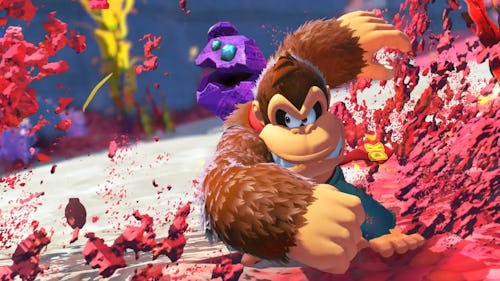A New Era of Gaming with Donkey Kong Bananza
Donkey Kong Bananza marks Nintendo’s highly anticipated debut on the Switch 2. This ambitious single-player game is a perfect complement to Mario Kart World, and it also represents the work of the same team that brought us Super Mario Odyssey. The concept for Bananza even originated from an outlandish idea where the team added arms to a Gooma. While the connection to Odyssey is evident, another major Nintendo title has also left its mark on this new adventure—Splatoon.
At first glance, the link between Splatoon and Bananza might not be obvious. However, upon closer inspection, many of Bananza’s core elements seem to draw inspiration from Nintendo’s innovative neon-drenched shooter trilogy. It’s not just about multiplayer or shooting mechanics; rather, it’s about the campaign structure, world interaction, and overall vibe that Splatoon brings to the table.
Bananza builds on the long legacy of Donkey Kong while introducing a fresh visual design that gives DK a completely new aesthetic. This new look mirrors the vibrant and colorful worlds found in Splatoon, featuring expressive characters with exaggerated movements and facial animations. While Mario also embodies this style, Bananza’s locations stand out in a way that Odyssey didn’t quite achieve. From neon green swamps with purple poisonous pits to glowing red volcanoes that feel blindingly bright, the game offers a visually striking experience.
The soundtrack of Bananza is another standout feature. It blends punchy pop songs, low-fi beats, and rock anthems into a complex and immersive mix. Music plays a crucial role in the narrative and game structure, with unique audio cues each time players gain a skill point. If you played it without context, you might easily mistake it for a track from Splatoon 3.
Beyond visuals and music, the structure of Bananza reflects the influence of Splatoon. The game features challenge missions that are similar to those found in Splatoon 2 and 3. These campaigns offer a larger world to explore, filled with little missions and challenges tailored around specific weapons, skills, or gameplay ideas. This approach allows players to learn how to play while also giving Nintendo a chance to craft a more personalized experience.
Bananza’s skill system rewards players for completing these challenges, enhancing DK’s abilities with skills like punching harder or making Bananzas last longer. This system is reminiscent of Gear Abilities in Splatoon 3, which enhance the player’s skillset in creative ways.
Compared to Mario Odyssey, which integrated most of its challenges and puzzles into the world itself, Bananza takes a different approach. Because of its ambitious destruction and transformations, this format makes more sense. Splatoon establishes a ruleset for players right from the start, allowing them to understand the game’s mechanics. Then, through clever mission design, it twists that understanding in surprising ways, much like Bananza does.
The final boss of Bananza, like in Splatoon 3, requires players to use every skill and mechanic they’ve learned throughout the game. This similarity highlights the deep influence of Splatoon on Bananza’s design.
It almost feels as if Bananza is divided into two halves. One half focuses on freedom and player agency, offering tools to explore and shape the world in the style of Mario Odyssey. The other half aligns with Splatoon’s experience, using those tools and the established world to create inventive mission designs.
While the teams behind Splatoon and Odyssey are entirely separate, their shared institutional knowledge allows for a seamless integration of ideas across different games. This collaborative approach is one of the reasons why Nintendo continues to innovate in ways that others haven’t.
I have always believed that Splatoon is one of the most important games of the last decade, not only for redefining shooters but also for reshaping Nintendo’s design ethos. Seeing how its ideas and style have influenced Bananza reinforces this belief. The concept of games and teams building upon each other’s success is what excites me the most about the future of the Switch 2.
Donkey Kong Bananza launches on July 17 for Nintendo Switch 2.







